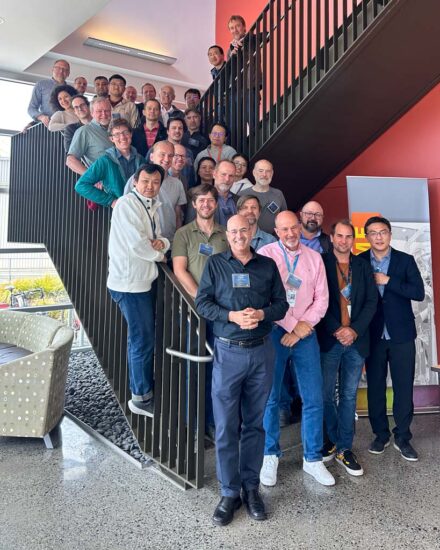by Kenneth Goldberg

At the end of May, the ALS hosted its first Beamline Optics and Modeling School (BLOMS 2023), a three-day, hands-on workshop to teach the theory, methods, strategy, and tools used to design and model x-ray beamlines. Recent retirements and departures from the ALS have left fewer people in the division with these skills. So, with the APS shutting down for its major upgrade, we took this opportunity to invite experts from four other light sources and one private company to show us the capabilities of modern, freely available tools and demystify the process of x-ray source and beamline modeling.
The meeting was chaired by Kenneth Goldberg and Antoine Wojdyla of the ALS Photon Science Development Group, with the help of the ALS administrative team and support from division management in making the course, and the meals, free for the students who attended. Many thanks go to Andrea Taylor and Heidi Clark for planning and execution and Angela Setiadi, Sheena Ryan, and Amanda Espiritu for support.
Our teachers were Manuel Sanchez del Rio (ESRF), Luca Rebuffi and Xianbo Shi (APS), Oleg Chubar and Max Rakitin (NSLS-II), Matthew Seaberg (SLAC), Antoine Wojdyla (ALS), and Boaz Nash (Radiasoft LLC). About 75 students attended in total, half of them remote, due to limited capacity. Students who attended in person came from all DOE light source facilities and from as far away as Trieste, Italy.

Lectures included fundamental aspects of sources, optical coherence, mirrors, gratings, and optical tolerancing as a foundation for all other work. The overlapping and complementary ray-tracing and wave-propagation approaches are both accessible in the major modeling platforms that were presented. First was the OASYS Suite, which is a cross-platform application that integrates SHADOW for ray tracing, SRW (Synchrotron Radiation Workshop) for source modeling and wave propagation, and several other important packages. OASYS has an intuitive visual interface that lets users tie together various modeling systems and intermediate diagnostics. Its primary developers are Sanchez del Rio and Rebuffi, who are celebrating 10 years since OASYS’s first line of code. The second was Sirepo, created by RadiaSoft, a Colorado-based company that developed the software as a Small Business Innovation Research (SBIR) project in collaboration with DOE scientists. Sirepo uses a simple web-based interface to access a similar set of tools. SRW, presented by its developer Oleg Chubar, can model the synchrotron light output from arbitrary bending magnets and insertion devices in addition to beamline optical elements. It is incorporated into both OASYS and Sirepo. SRW is entering its 26th year of development.
Most importantly, all of these platforms now offer Python libraries and can output models directly into Python scripts, so users can take their designs into Jupyter notebooks (for example) and develop their own analyses and optimizations. We discussed a few other programs, including XRT, SPECTRA, RayUI, Urgent, and WISER.
The course applied the tools to the study of two beamline examples: a soft x-ray beamline with a grating monochromator, and a hard x-ray beamline with a double-crystal monochromator. Ray tracing is fast and powerful. Wave propagation is especially important for modeling coherent x-ray light, including optical surface specifications, in this burgeoning era of diffraction-limited light sources. We also studied x-ray power-density modeling, which is a major concern for safety and for thermal engineering. Students brought their own questions and problems to the final day, to work on in groups or one-to-one with the instructors.
There is a tremendous amount of physics incorporated into these modern tools, and they can run on laptops or supercomputers. Thanks to a small number of dedicated developers who share their work with the community, they are undergoing continuous refinement and improvement. We are in their debt.
In my view, the meeting achieved its objectives, exposing a new generation to these methods and tools, making new friends and contacts in this small, helpful community of beamline designers, engineers, and scientists. Our evenings out in Berkeley were filled with lessons learned the hard way and stories about how far we’ve come in this field. As organizers, our hope is to inspire more people to model their beamlines, probe interesting new designs, and share what they are doing in these common, interchangeable platforms—possibly also to join those making significant contributions to their development. In the end, the rays and waves got along, and we resolved to do this again in the not-distant future.
